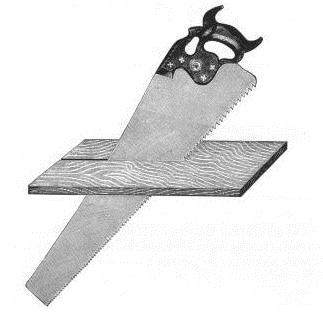

"What's in a Name?"
Tenon Saw? Panel Saw? Hand Saw?
Pete Taran
There are a bewildering number of names for just two of the most common saws found in the average woodworking shop. This article will discuss the two most common saws used in woodworking, the back saw and the handsaw.
The definitions of names for various saws vary with the manufacturer. Since Henry Disston & Sons were by far the largest saw maker, and more examples exist of their work than any other, the classes of saws set up by Disston will be used in this article.
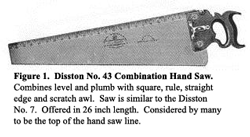 It may interest the reader to know
that the term "hand saw" only applies to the 26 inch
crosscut. A typical hand saw consists of a piece of tempered steel
to which has been fastened a wooden handle by three or more brass
screws. Handsaws were available in a variety of pitches, the most
common was the 26 inch crosscut in 8 points, but pitches from
5 to 12 points per inch (ppi) were available. It is important
to note that for every rule there are exceptions. Most saw makers
of the 19th and 20th Century prided themselves on their ability
to supply custom work, and many examples exist of saws which don't
fit into any catalog description. In addition, as time went by,
more and more saws were eliminated from a company's offerings.
As an example, in 1914, Disston offered their #7 rip saw in lengths
from 28 to 36 inches, but by 1918, the range stopped at 28 inches-in
a space of only four years!
It may interest the reader to know
that the term "hand saw" only applies to the 26 inch
crosscut. A typical hand saw consists of a piece of tempered steel
to which has been fastened a wooden handle by three or more brass
screws. Handsaws were available in a variety of pitches, the most
common was the 26 inch crosscut in 8 points, but pitches from
5 to 12 points per inch (ppi) were available. It is important
to note that for every rule there are exceptions. Most saw makers
of the 19th and 20th Century prided themselves on their ability
to supply custom work, and many examples exist of saws which don't
fit into any catalog description. In addition, as time went by,
more and more saws were eliminated from a company's offerings.
As an example, in 1914, Disston offered their #7 rip saw in lengths
from 28 to 36 inches, but by 1918, the range stopped at 28 inches-in
a space of only four years!
The pitch of the saw often defined what it was used for. Hand saws with very coarse teeth, 5-7 points per inch (ppi), were used for very rough cuts in unfinished or unseasoned lumber when speed and efficiency were more important than quality of finish. Hand saws with teeth in the 8-9 ppi range were the most common and were used for general purpose work, in both rough and dressed stock. Hand saws with teeth from 10-12 points were almost always used where the surface finish was the greatest concern. These hand saws were typically used on dressed stock, often in situations where the cut was not further smoothed with a plane.
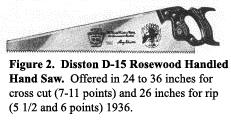 Rip saws were generally available
in lengths from 26 to 30 inches. Their manner of construction
was the same as that for hand saws and were offered in pitches
from 3 1/2 to 7 ppi. Rip saws with 3 1/2 to 5 ppi were used mostly
on rough unseasoned lumber. A rip saw with 3 1/2 ppi can rip a
board at amazing speed, sometimes averaging 2 inches per stroke
in some species of wood! By far the most common rip saw sold was
cut with 5 1/2 ppi, a pitch that was well suited for general work
in both dry and seasoned lumber that was rough or planed. Less
common are rip saws with 6 to 7 ppi which were used in finish
applications where little planing was desired after the cut. These
saws cut slow, but where a fine finish was desired, were in high
demand.
Rip saws were generally available
in lengths from 26 to 30 inches. Their manner of construction
was the same as that for hand saws and were offered in pitches
from 3 1/2 to 7 ppi. Rip saws with 3 1/2 to 5 ppi were used mostly
on rough unseasoned lumber. A rip saw with 3 1/2 ppi can rip a
board at amazing speed, sometimes averaging 2 inches per stroke
in some species of wood! By far the most common rip saw sold was
cut with 5 1/2 ppi, a pitch that was well suited for general work
in both dry and seasoned lumber that was rough or planed. Less
common are rip saws with 6 to 7 ppi which were used in finish
applications where little planing was desired after the cut. These
saws cut slow, but where a fine finish was desired, were in high
demand.
The term panel saw defines a large class of saws that varied in length from 16 to 24 inches. They were available in both crosscut and rip style teeth and in general, fewer pitches than their bigger cousins, the hand saw and the rip saw. Panel saws were used much more in the cabinet shop than on the general construction job site. Their smaller size was convenient for working inside the shop, making cuts almost exclusively in seasoned, dressed stock. This type of saw was also popular in manual training schools for boys, where a full sized saw would be too unwieldy. Typical uses for panel saws were cutting and ripping stock to a final dimension. By far the most common panel saw found is the 24 inch 9 point. Less common are panel saws with rip teeth, although they are not rare. The most common rip panel saw is the 7 point. In addition, more and more variety of pitches were available as the saw length approached a full size hand or rip saw. For instance, in 1918, the D8 crosscut panel saw was available in 9 and 10 ppi in the 16 inch length, but at 24 inches was available in 7-11 points per inch. A favorite use for the rip panel saw was cutting tenon cheeks in work that was too big for the ordinary back saw.
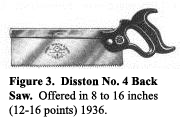 The term back saw refers to any
saw which has a blade which is much thinner than a hand or rip
saw and has been stiffened by a folded piece of metal which is
crimped on the upper portion of the blade. This piece of metal,
"the back," was most commonly offered in either polished
or blued steel, but polished brass backs, while less common, were
also available. The handle was fastened to the blade and back
assembly with at least two, but sometimes three or more saw screws.
Most back saws have handles that are closed, that is, the hand
is entirely surrounded by wood. Some back saws were offered with
open style handles. These saws were much more common in England
than in the United States.
The term back saw refers to any
saw which has a blade which is much thinner than a hand or rip
saw and has been stiffened by a folded piece of metal which is
crimped on the upper portion of the blade. This piece of metal,
"the back," was most commonly offered in either polished
or blued steel, but polished brass backs, while less common, were
also available. The handle was fastened to the blade and back
assembly with at least two, but sometimes three or more saw screws.
Most back saws have handles that are closed, that is, the hand
is entirely surrounded by wood. Some back saws were offered with
open style handles. These saws were much more common in England
than in the United States.
The common back saw was offered in lengths from 8 to 18 inches and in both cross cut and rip tooth styles. By far the most common back saw seen is the 12 inch, 13 ppi crosscut. Crosscut back saws were also offered in 12 to 16 ppi. Almost as common is the 12 inch, 10 point rip. Rip back saws were offered in pitches from 8-12 ppi. Virtually all back saws were used inside the confines of the shop to execute joinery. In general, the longer the saw, the wider the blade, which allowed thicker and thicker stock to be worked.
 There are several special classes
of back saws which were given special names due to the work that
they performed. Miter saws were large back saws with very wide
blades used in a miter box to cut molding or other types of work.
They were available in lengths from 20 to 32 inches. Due to the
nature of the work, they were almost exclusively offered in a
12 ppi cross cut configuration.
There are several special classes
of back saws which were given special names due to the work that
they performed. Miter saws were large back saws with very wide
blades used in a miter box to cut molding or other types of work.
They were available in lengths from 20 to 32 inches. Due to the
nature of the work, they were almost exclusively offered in a
12 ppi cross cut configuration.
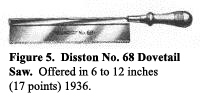 The dovetail saw is another special
class of back saw that was commonly found in use in cabinet shops.
Most dovetail saws were offered in lengths from 8 to 10 inches,
with rip teeth in pitches from 14-17 ppi. Since most dovetail
saws were used on 7/8 inch dressed lumber, most have a very narrow
blade for greater control and stiffness. Dovetail saws are unique
in that they were offered with three different types of handles:
open, closed, and also with a turned handle. Many people confuse
short back saws with dovetail saws. It is often difficult to tell
then apart, but dovetail saws almost always have a much thinner
blade and more graceful handle than the ordinary back saw.
The dovetail saw is another special
class of back saw that was commonly found in use in cabinet shops.
Most dovetail saws were offered in lengths from 8 to 10 inches,
with rip teeth in pitches from 14-17 ppi. Since most dovetail
saws were used on 7/8 inch dressed lumber, most have a very narrow
blade for greater control and stiffness. Dovetail saws are unique
in that they were offered with three different types of handles:
open, closed, and also with a turned handle. Many people confuse
short back saws with dovetail saws. It is often difficult to tell
then apart, but dovetail saws almost always have a much thinner
blade and more graceful handle than the ordinary back saw.
Of interest are some of the obsolete names that refer to back saws from the 18th and early 19th century. I include them since some early British saws turn up, and it is useful to know the proper names for them.
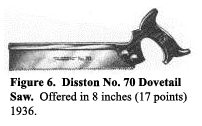 The Tonond, or Tenon Saw was the
largest of the back saws and was made in lengths from 18 to 20
inches. As the name suggests, it was used for cutting tenon cheeks,
and was most commonly found in a 10 ppi rip configuration. This
particular name has "stuck" and is commonly used to
refer to any back saw. Next was the Sash saw, commonly found in
a 14 inch length and offered in 13 ppi, both crosscut and rip.
This was the general purpose back saw, and was used widely in
most shops. The Carcass saw was found in 11 to 12 inch lengths
and was primarily made in a 14 ppi crosscut configuration. It
was used to cut very precise joinery across the grain. Finally,
the Dovetail saw was offered in most commonly a 9 inch length,
in pitches from 16-20 ppi.
The Tonond, or Tenon Saw was the
largest of the back saws and was made in lengths from 18 to 20
inches. As the name suggests, it was used for cutting tenon cheeks,
and was most commonly found in a 10 ppi rip configuration. This
particular name has "stuck" and is commonly used to
refer to any back saw. Next was the Sash saw, commonly found in
a 14 inch length and offered in 13 ppi, both crosscut and rip.
This was the general purpose back saw, and was used widely in
most shops. The Carcass saw was found in 11 to 12 inch lengths
and was primarily made in a 14 ppi crosscut configuration. It
was used to cut very precise joinery across the grain. Finally,
the Dovetail saw was offered in most commonly a 9 inch length,
in pitches from 16-20 ppi.
Hopefully, this article will have educated the reader on the various forms and uses of some of the most common saws that are found. It is by no means a definitive list, but rather a general outline that can be useful when picking out saws on the vintage tool market.
Photos from: Disston Handbook on Saws, 1907; Disston Saw, Tool and File Manual, 1936.